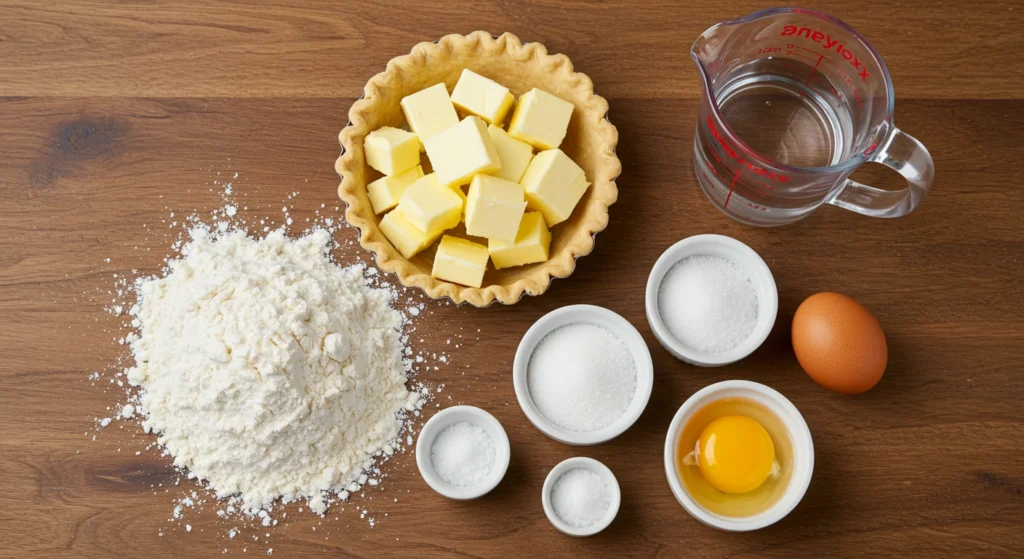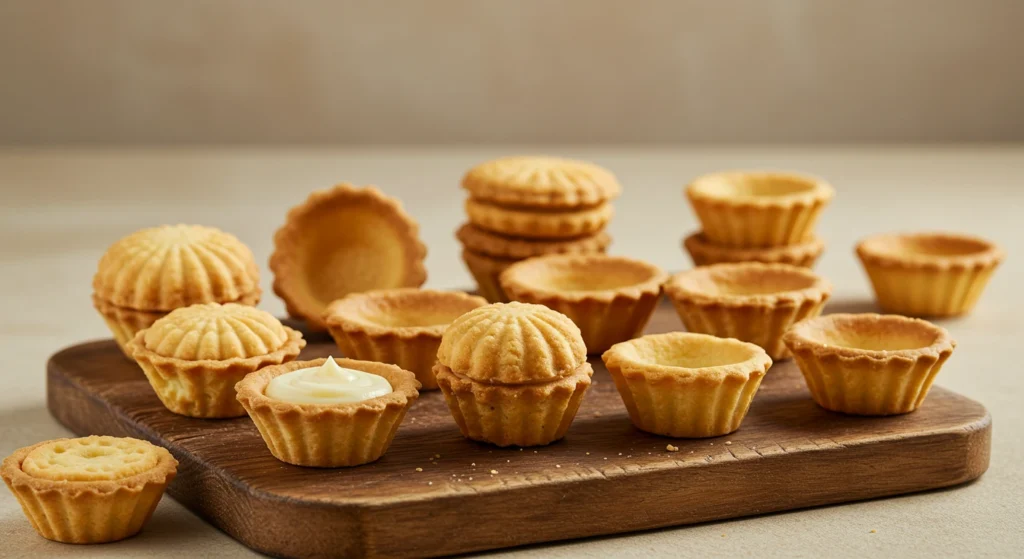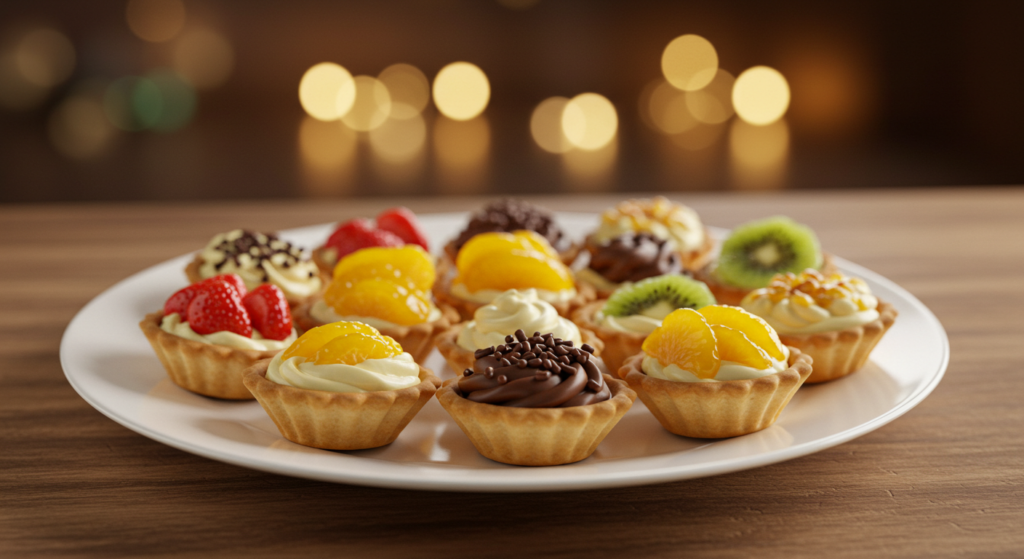What Are Dessert Shells?
Definition and Purpose
Growing up, I would often watch my mom bake delicate pastries in the kitchen, her hands expertly shaping and filling crisp, golden shells that would later be filled with sweet cream, fruits, or custards. These shells, I learned, are not just edible containers but key elements that make desserts extraordinary. are typically small, hollow pastry structures used to hold sweet fillings, ranging from whipped cream to chocolate mousse, fruit, or even ice cream. Their purpose is simple: to create a contrast in texture between the crisp shell and the soft filling. Whether flaky, crunchy, or light, dessert provide a structural base for sweet fillings, offering a satisfying bite with each mouthful.
One of the most appealing aspects is their versatility. They can be used to create individual portions or larger, more elaborate desserts, such as pies or tarts. The shells serve as both a base and a framework for diverse fillings, making them a go-to for anyone looking to create a sophisticated and flavorful treat.
Different Types of Dessert Shells
I often find myself selecting between different types , depending on the kind of dessert I’m preparing. Here are the most common:
- Mini : These bite-sized shells are perfect for creating individual servings, often pre-baked and sold in bulk.
- Large : These are ideal for larger, shareable desserts like pies or tarts, offering a more substantial base for fillings.
- Choux Pastry Shells: Light and airy, these shells are a popular choice for cream puffs or éclairs, providing a delicate, crispy texture.
- Phyllo Shells: Made from thin layers of dough, phyllo shells are crispy and flaky, perfect for holding light, delicate fillings.
Each type of shell serves a distinct purpose, and knowing which one to choose can make a significant difference in the final presentation and flavor of your dessert.
Best Dessert for Every Occasion
Mini Dessert versus Large
When deciding between mini and larger options, I often think about the type of gathering and how the dessert will be served. are a great choice for parties, buffets, or events where individual servings are needed. These smaller shells make it easier to create bite-sized, elegant desserts that guests can grab and enjoy with minimal mess. I’ve used them for everything from mini tarts filled with fruit to petit fours with chocolate mousse. Their size and convenience make them a practical choice when I want to offer a variety of desserts without overwhelming guests.
On the other hand, large are perfect for more formal or family-style gatherings. Think about a classic fruit tart with a creamy custard filling or a chocolate tart that you cut into slices. Large shells provide a more dramatic presentation and allow for more creative, generous fillings. They also have the advantage of being simpler to assemble when serving a larger group, as you only need to prepare one large dessert instead of multiple individual servings.
Pre-made vs. Homemade
Whether I’m short on time or feeling particularly ambitious, the choice between pre-made dessert shells and homemade ones depends on my schedule. are incredibly convenient when I need a quick solution. These shells are often available in the baking aisle of grocery stores and come in various forms, from mini tart shells to larger pie shells. They save me time and effort, allowing me to focus on preparing fillings and toppings instead of spending hours making dough.
However, when I’m in the mood for a more personalized touch, I prefer to make homemade dessert shells from scratch. While it’s a more time-consuming process, the end result is worth the effort. Homemade shells allow me to control the texture and flavor whether I’m making a rich, buttery shortcrust or a light, flaky puff pastry. The satisfaction of creating something from scratch enhances the overall experience of making dessert.
How to Use Dessert Shells in Desserts
Simple Ways to Serve
offer endless possibilities for creativity, but sometimes simplicity is the best approach. One of the easiest ways I use dessert shells is to fill them with a dollop of whipped cream and top them with fresh fruit. I love using berries like strawberries, raspberries, and blueberries, as they add color and freshness. A sprinkle of powdered sugar and a drizzle of chocolate or caramel sauce adds a touch of indulgence. This method is not only quick but also highlights the delicate crunch of the shell and the sweetness of the filling.
Another simple yet elegant option is to fill the shells with custard or mousse, offering a smooth and creamy contrast to the crunchy shell. For example, I’ve used a rich vanilla custard paired with sliced bananas or lemon curd with fresh berries for a tangy twist. This type of dessert requires minimal effort but always impresses guests with its beauty and flavor.
Creative Ideas for Stuffing and Filling Dessert
If I have a little more time or am looking to get more creative, there are countless ways to stuff and fill dessert . A popular option is to combine cream cheese with whipped cream, creating a lighter filling that pairs beautifully with fruit. I’ve also experimented with chocolate mousse, which adds a rich and indulgent layer inside the shell. Sometimes, I like to add a twist by incorporating spices like cinnamon or nutmeg into the filling for extra warmth and depth of flavor.
For a more tropical flavor, I’ve used coconut cream or mango puree to fill the shells, creating a dessert that transports me to a sunny beach. The possibilities are endless, and the key is balancing the texture of the shell with the creaminess or richness of the filling to create a harmonious bite.
Popular Fillings for Dessert
Fruit-Based Fillings for
When I want a light and refreshing filling, I often turn to fruit-based options. One of my favorite combinations is fresh berries mixed with a sweetened cream cheese or mascarpone filling. This simple yet delicious treat is perfect for summer when fruits are in season. The natural sweetness and acidity of fruits like strawberries, raspberries, and blueberries contrast beautifully with the rich, creamy filling and the crisp texture of the shell.
In the fall, I love using apples or pears, often paired with a touch of cinnamon or caramel to complement their natural sweetness. A fruit compote, made by simmering fruit with sugar and spices until it thickens, can also be used as a filling. The warm flavors of the compote combined with the cool, crisp shell create a wonderful balance.
Creamy Fillings for Dessert
When I’m looking for something rich and indulgent, I often opt for creamy fillings like custards or chocolate mousse. Vanilla custard, for example, is a classic that never goes out of style. Its velvety texture and delicate flavor are the perfect match for a dessert l. Alternatively, chocolate mousse offers a decadent filling that contrasts nicely with the crunchy shell. Sometimes I mix a little espresso into the mousse for an extra layer of complexity.
Another creamy option I enjoy is lemon curd, which provides a zesty, tangy contrast to the sweet and buttery shell. The brightness of lemon curd can lighten up even the heaviest of desserts, making it an excellent choice for pairing with a variety of shells.
Chocolate and Nut Fillings for Shells
For a more decadent dessert, I often look to chocolate and nut fillings. One favorite is chocolate ganache mixed with chopped hazelnuts, offering a smooth, rich filling with a delightful crunch. The hazelnuts bring a slight bitterness that complements the sweetness of the chocolate, creating a sophisticated flavor profile. I’ve also used caramelized almonds or pecans, which add a nutty sweetness that pairs well with both dark and milk chocolate.
If I’m feeling adventurous, I also like to make peanut butter mousse or fill shells with Nutella for a rich, creamy filling. Nutella, with its perfect balance of chocolate and hazelnut, works wonderfully in combination with a simple shell, elevating the dessert to a new level of indulgence.
Customizing Dessert Shells for Dietary Preferences
When preparing desserts for guests with dietary restrictions, I find that customizing can make all the difference. For those with gluten sensitivities, I’ve had success using gluten-free flours like almond flour or rice flour to create shells that maintain their crisp texture without sacrificing flavor. For vegan guests, I substitute dairy with coconut cream or almond milk, ensuring the filling is just as rich and satisfying. I also make sure to select plant-based oils or vegan butter when creating the shells to keep everything dairy-free.
In my experience, these modifications ensure that everyone, regardless of dietary preference, can enjoy a delicious dessert filled with their favorite flavors.
Ingredients :
When it comes to crafting the perfect shells, the right ingredients make all the difference. Whether you’re aiming for a light and flaky shell or a rich, buttery base, each component plays a key role in achieving the ideal texture and flavor. Here’s what you’ll need:

For the Basic Shortcrust Pastry Shell:
- 1 1/4 cups all-purpose flour – This forms the foundation of the shell. Use a high-quality flour for the best texture.
- 1/2 cup unsalted butter – Cold and cut into small cubes. This ensures your shell is flaky and tender.
- 2 tablespoons granulated sugar – Just a touch to bring a hint of sweetness to the pastry.
- 1/4 teaspoon salt – Enhances all the flavors and balances the sweetness.
- 1 egg yolk – Adds richness and helps bind the dough.
- Cold water – Start with 2-3 tablespoons, adding just enough to bring the dough together.
For a Flaky Phyllo Shell:
- Phyllo dough sheets – Use about 6-8 sheets. This delicate dough creates a super crispy, light shell.
- 1/2 cup melted butter or vegetable oil – For brushing between the phyllo layers to achieve that golden crispness.
- 1/4 teaspoon salt – Just a pinch to balance the flavors.
Tips for Success:
- For a buttery, crumbly shortcrust: Make sure the butter is cold before mixing. This will create the flaky texture we all love in pastry shells.
- When using phyllo dough: Be gentle and work quickly! Phyllo sheets dry out fast, so make sure to cover them with a damp cloth while assembling the layers.
- For perfect choux pastry: Keep an eye on the dough as it cooks when the dough forms a smooth ball and pulls away from the sides of the pan, it’s time to move on to the next step.
With these ingredients in hand, you’re well on your way to creating the most delicious, buttery, and crispy to fill with your favorite fillings. Happy baking!
How to Prepare

Preparing Pre-made Dessert Shells
In moments when I’m pressed for time or want to streamline my dessert preparation, pre-made dessert are my go-to. These shells are available at most grocery stores and come in various sizes and forms. To prepare them, I typically remove them from the packaging and place them on a clean, dry surface. If the shells have been frozen, I let them thaw for a few minutes at room temperature. Once they’re ready, I fill them with my chosen fillings, ensuring I don’t overstuff them to maintain the structural integrity of the shell.
For extra freshness, I like to chill the filled shells in the fridge for about 15-30 minutes. This helps the filling set and allows the flavors to meld, giving me a delicious, ready-to-serve dessert.
Making Homemade Dessert Shells from Scratch
There’s something immensely satisfying about making from scratch. For this, I begin with a base dough, usually a shortcrust or puff pastry, depending on the desired texture. I roll the dough out to a thin layer and carefully fit it into tart pans or molds. Once the shells are shaped, I bake them until golden and crisp. This process can be a bit time-consuming, but the results are always worth it. I also appreciate the control it gives me over the flavor and texture of the shells, allowing me to adjust the ingredients to suit my tastes.
Step-by-Step Guide to Assembling the Perfect Dessert Shell
To assemble the perfect dessert , I follow a few simple steps:
- Bake the shell: If using pre-made shells, ensure they’re fully thawed and crisped if necessary. For homemade shells, bake until golden brown.
- Prepare the filling: Whip up your desired filling, whether it’s a light cream, decadent mousse, or fruity compote.
- Fill the shells: Spoon or pipe the filling into the shells, leaving a bit of space at the top for garnishing.
- Garnish: Add your choice of toppings, such as fresh fruit, whipped cream, or chocolate shavings, to finish the dessert.
- Chill: Refrigerate the assembled shells for about 30 minutes to ensure the filling sets and the flavors meld together.

By following these steps, I guarantee that my dessert will hold up beautifully, maintain their crisp texture, and present a delightful balance of flavors.
Dessert Shells for Special Diets
Gluten-Free Dessert
As someone who enjoys preparing treats for family and friends with dietary restrictions, I’ve learned how to create gluten-free dessert that are just as delicious as the traditional variety. Almond flour and rice flour are excellent substitutes for regular wheat flour and contribute to a light, crisp texture. These gluten-free shells can be used in the same way as traditional shells, and I often pair them with fruit-based fillings or light creams to create a balanced dessert.
Low-Calorie Dessert
For those watching their calorie intake, I enjoy making low-calorie dessert by reducing the amount of butter and sugar in the dough. Instead, I use healthier alternatives like coconut oil or stevia to maintain the flavor without the extra calories. These shells are light and crisp, making them a perfect choice when paired with low-calorie fillings like Greek yogurt or berries.
Vegan Dessert
Creating vegan dessert has become a regular practice in my kitchen. By using plant-based substitutes like almond milk and vegan butter, I can create shells that are just as flaky and delicious as traditional ones. I’ve experimented with various fillings, from coconut-based creams to silken tofu chocolate mousse, ensuring the dessert is entirely vegan and delicious.
Sugar-Free Dessert
For those who need to limit their sugar intake, I often prepare sugar-free . Using sugar substitutes like erythritol or stevia allows me to create shells with the same crispiness and flavor as traditional ones but without the added sugar. These shells pair wonderfully with naturally sweet fillings like fresh fruit or sugar-free whipped cream, making them a guilt-free indulgence.
Storing and Freezing
How to Store for Maximum Freshness
To keep my dessert as fresh as possible, I store them in an airtight container at room temperature. This prevents moisture from making the shells soggy. If I need to store them for a longer period, I place them in a sealed plastic bag or wrap them in plastic wrap to keep out air. Proper storage helps maintain their crisp texture, allowing them to be ready for use whenever needed.
How Long Can You Freeze ?
I’ve learned that I can freeze for up to three months, which is particularly helpful when I prepare large batches ahead of time. To freeze them, I place the shells on a baking sheet in a single layer, ensuring they don’t touch. Once they’re frozen solid, I transfer them to a resealable bag or airtight container. When ready to use, I simply thaw them at room temperature.
How to Thaw and Use Frozen
Thawing frozen dessert is simple. I remove them from the freezer and let them sit at room temperature for about 15 to 30 minutes. If I’m in a hurry, I sometimes warm them slightly in the oven at a low temperature to restore their crispness. After thawing, I can proceed to fill them with my desired fillings, ensuring that they maintain their texture and flavor.
in Popular Desserts
Individual Desserts Using
One of my favorite ways to use is by creating individual servings. These bite-sized desserts are not only easy to eat but also allow for a diverse range of flavors and combinations. I often use mini dessert to create small servings of fruit tarts or chocolate mousse cups. The individual portions allow each guest to enjoy a personal dessert, making them perfect for parties, weddings, or any event where finger foods are preferred.
in Pies and Tarts
Another classic use of dessert is in pies and tarts. The crispy, flaky base provides a sturdy foundation for a variety of sweet fillings. I’ve made everything from lemon meringue pies to classic apple tarts. The richness of the shell complements the filling, and its crisp texture contrasts beautifully with the creamy or fruity interior. Whether I’m preparing a traditional pecan pie or a more exotic mango tart, the dessert shell always plays a crucial role in creating a well-rounded dessert.
Pairing Dessert with Different Types of Toppings
Toppings are an essential part , as they help enhance the flavor and appearance of the dessert. Fresh fruit like berries, sliced kiwis, or mango chunks provide a burst of freshness. Whipped cream or ice cream can add a rich, indulgent element. For more decadent options, I love sprinkling chocolate shavings, caramel sauce, or toasted nuts on top. These toppings not only complement the filling but also add textural contrast to the dessert.
Dessert for Entertaining
Impressive Desserts for Parties Using Dessert
Whenever I host a party, I rely on dessert shells to make my desserts look and feel extra special. One crowd favorite is the mini tart filled with lemon curd and topped with fresh berries. These tiny, beautiful desserts are easy to prepare and perfect for guests to nibble on during a party. Mini cream puffs, filled with whipped cream and dipped in chocolate, are another great option. The presentation of these mini desserts always brings compliments and adds a touch of sophistication to the event.
Dessert for Holidays and Celebrations
During holidays like Christmas or Thanksgiving, I often make larger, shareable desserts using dessert shells. Fruit tarts with a colorful medley of seasonal fruits or a decadent chocolate mousse tart are always a hit at family gatherings. These desserts feel festive and can be customized to suit the season’s flavors, like using pumpkin pie filling for fall or cherry compote for summer. The versatility of dessert shells makes them an excellent choice for holiday celebrations.
Nutritional Information and Health Benefits
How Many Calories Are in a Dessert Shell?
The calorie content of dessert shells can vary based on their size and the ingredients used. On average, a mini dessert shell contains approximately 100-150 calories, depending on whether it’s made with butter, sugar, or lighter alternatives. Larger shells, such as those used for pies or tarts, can have more calories, ranging from 200 to 300 calories per serving.
How Many Carbs Are in Dessert Shells?
The carbohydrate content in dessert shells can range from 10-20 grams of carbs per mini shell, with most of the carbs coming from flour and sugar. Gluten-free and low-carb shells will have fewer carbohydrates, depending on the flour or sweetener substitutes used.
The Nutritional Value of Stuffed Shells
The nutritional value of stuffed dessert depends largely on the filling. A simple fruit-filled shell will be rich in vitamins and fiber, while a chocolate mousse or custard-filled shell will be higher in fats and sugars. To make a healthier dessert, I often choose fruit-based fillings or Greek yogurt to provide a protein boost.
Are Shells a Healthy Dessert Option?
While dessert can be enjoyed as part of a balanced diet, they are generally not considered a health food. However, by choosing lighter fillings, such as fruit, Greek yogurt, or sugar-free options, it is possible to enjoy them in a healthier manner. For those seeking to reduce calories or sugar, there are plenty of alternatives available to ensure a delicious yet guilt-free dessert.
_______________________________________________

dessert shells
Ingredients
For the Basic Shortcrust Pastry Shell:
- 1 1/4 cups all-purpose flour – This forms the foundation of the shell. Use a high-quality flour for the best texture.
- 1/2 cup unsalted butter – Cold and cut into small cubes. This ensures your shell is flaky and tender.
- 2 tablespoons granulated sugar – Just a touch to bring a hint of sweetness to the pastry.
- 1/4 teaspoon salt – Enhances all the flavors and balances the sweetness.
- 1 egg yolk – Adds richness and helps bind the dough.
- Cold water – Start with 2-3 tablespoons adding just enough to bring the dough together.
For a Flaky Phyllo Shell:
- Phyllo dough sheets – Use about 6-8 sheets. This delicate dough creates a super crispy light shell.
- 1/2 cup melted butter or vegetable oil – For brushing between the phyllo layers to achieve that golden crispness.
- 1/4 teaspoon salt – Just a pinch to balance the flavors.
Instructions
Step-by-Step Guide to Assembling the Perfect Dessert Shell
- To assemble the perfect dessert shell, I follow a few simple steps:
- Bake the shell: If using pre-made shells, ensure they’re fully thawed and crisped if necessary. For homemade shells, bake until golden brown.
- Prepare the filling: Whip up your desired filling, whether it’s a light cream, decadent mousse, or fruity compote.
- Fill the shells: Spoon or pipe the filling into the shells, leaving a bit of space at the top for garnishing.
- Garnish: Add your choice of toppings, such as fresh fruit, whipped cream, or chocolate shavings, to finish the dessert.
- Chill: Refrigerate the assembled shells for about 30 minutes to ensure the filling sets and the flavors meld together.
Notes
Nutrition Information (Per Serving)
- Calories: 250 kcal
- Total Fat: 12g
- Saturated Fat: 5g
- Trans Fat: 0g
- Cholesterol: 25mg
- Sodium: 95mg
- Total Carbohydrates: 35g
- Dietary Fiber: 2g
- Sugars: 22g
- Protein: 3g
- Vitamin D: 1mcg (5% DV)
- Calcium: 50mg (4% DV)
- Iron: 1mg (6% DV)
- Potassium: 170mg (5% DV)
Conclusion
Dessert shells are a versatile and essential element in creating delicious, visually appealing treats. Whether using mini dessert for individual servings or crafting a larger tart, these shells serve as the perfect base for a wide variety of fillings, from fruity to creamy. They offer options for every dietary preference, including gluten-free, vegan, and sugar-free choices. Dessert shells enhance both flavor and texture, making them ideal for any occasion, whether casual or celebratory. Simple to prepare and endlessly customizable, they are a must-have for anyone looking to elevate their dessert game.
How Long Can You Freeze Dessert Shells?
can typically be frozen for up to three months when stored properly in an airtight container or wrapped in plastic wrap. Freezing helps preserve their crispness, and they can be thawed in the fridge before being filled.
How Many Carbs Are in Dessert Shells?
The number of carbs in dessert varies depending on the ingredients used. On average, a single mini dessert shell contains around 5–10 grams of carbohydrates. This can change if you’re using gluten-free or low-carb alternatives.
How Many Calories Are in a Dessert?
The calorie content of a dessert shell depends on the type of shell and filling used. A basic mini dessert shell, with a light filling, may contain between 100–150 calories per serving. Richer, cream-filled shells may have significantly more calories.
What Is the Nutritional Value of Stuffed Shells?
Stuffed dessert can vary widely in their nutritional value, depending on the filling. For example, a fruit-filled shell may offer
FAQs
How Long Can You Freeze Dessert Shells?
can typically be frozen for up to three months when stored properly in an airtight container or wrapped in plastic wrap. Freezing helps preserve their crispness, and they can be thawed in the fridge before being filled.
How Many Carbs Are in Dessert Shells?
The number of carbs in dessert varies depending on the ingredients used. On average, a single mini dessert shell contains around 5–10 grams of carbohydrates. This can change if you’re using gluten-free or low-carb alternatives.
How Many Calories Are in a Dessert?
The calorie content of a dessert shell depends on the type of shell and filling used. A basic mini dessert shell, with a light filling, may contain between 100–150 calories per serving. Richer, cream-filled shells may have significantly more calories.
What Is the Nutritional Value of Stuffed Shells?
Stuffed dessert can vary widely in their nutritional value, depending on the filling. For example, a fruit-filled shell may offer

